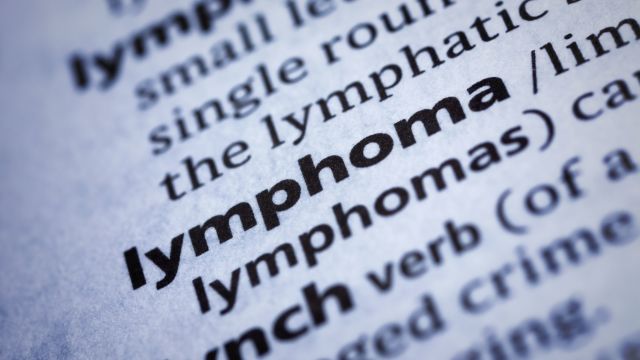Updated on April 4, 2024.
Lymphoma is a type of blood cancer in which white blood cells of the immune system develop changes that make them grow irregularly. If you or someone you know has been diagnosed with a form of lymphoma, the language used by healthcare providers and in medical information they provide may feel unfamiliar or confusing. Here are basic meanings of scientific terms related to this common type of cancer.
Aggressive lymphomas
Lymphomas that grow and spread rapidly. Sometimes called high-grade or intermediate-grade lymphomas, they cause severe symptoms and must be treated as soon as possible.
Allogeneic stem cell transplantation
A procedure where someone with lymphoma receives blood-forming stem cells (which are capable of developing into different types of blood cells) from a healthy person (a donor) who has a similar genetic makeup. The goal is to replace damaged cells with healthy ones. The donor could be either a relative or non-relative, as long as they have certain genes that are a similar match to the person receiving the transplant.
Antibodies
Proteins produced in the immune system that protect the body from antigens (foreign substances, such as viruses or bacteria, that may cause illness).
Apoptosis
A natural process in which the body rids itself of irregular cells. Also referred to as “cell death.”
Autologous stem cell transplantation
A procedure during which the patient has their own blood-forming stem cells (which are capable of developing into different types of blood cells) collected after diagnosis, stored during treatments and then placed back into them to replace cells that have been damaged during treatment.
B cells
White blood cells that make antibodies in the immune system. B cells develop from stem cells in the bone marrow.
Biopsy
The removal of tissue or cells from your body for examination. Incisional biopsies use a small tissue sample, while excisional biopsies involve cutting away of a diseased area. During a needle biopsy, a sample of tissue or fluid is removed using a needle. The results of a biopsy can help with making a diagnosis and deciding about treatment.
CAR-T cell therapy
T cells are white blood cells produced in the immune system that help your body fight off germs. In CAR-T cell therapy, T cells are removed from your own body, changed in a lab so they can attach to cancer cells and kill them, then replaced back into your body to fight cancer.
Chemotherapy
Medicines designed to treat cancer by destroying cancer cells throughout the body. Also referred to as “chemo.”
Clinical trial
Medical research studies that evaluate the effects of a medical product, behavior or procedure.
First-line treatment
The most accepted type of therapy used to treat a disease. Also referred to as induction therapy, primary therapy and primary treatment.
Hodgkin’s lymphoma
A cancer that starts in white blood cells (usually in the B cells) within the immune system. Certain large, irregular white blood cells called Reed-Sternberg cells are found in people with Hodgkin's lymphoma.
Immunotherapy
Treatment that increases or decreases your body’s immune system to help fight cancer. Immunotherapy can be directed toward specific types of immune cells or the immune system as a whole.
Indolent lymphomas
Also called low-grade lymphomas, indolent lymphomas are slow-growing and slow-spreading lymphomas that tend to cause few or minor symptoms. Healthcare providers may decide to observe instead of treat these types of lymphomas.
Lymph nodes or glands
Small bean-shaped structures located throughout the body, including your neck, underarms, chest and abdomen. Connected by lymphatic vessels (thin tubes that carry lymph fluid), lymph nodes act as filters for your immune system and contain white blood cells called lymphocytes, as well as other cells related to immunity.
Lymphoma
The most common form of blood cancer located in the lymphatic system, which is part of the immune system. The lymphatic system includes the lymph nodes, spleen (an organ found near the stomach that filters blood, stores blood cells, makes white blood cells, and gets rid of old blood cells), thymus gland (which is found in the upper chest and makes white blood cells), and bone marrow (spongy tissue inside bone that makes blood cells).
Lymphocytes
A type of white blood cell found in the immune system. The two main types of lymphocytes are B cells (which make antobodies) and T cells (which help fight infection and may play a role in fighting cancer). A third type is natural killer (NK) cells, which kill cancer cells or those infected with a virus.
Mantle cell lymphoma
A rare and aggressive form of non-Hodgkin’s lymphoma (NHL) that may affect the lymph nodes, spleen, bone marrow and blood, as well as the digestive tract.
Metastasis
Cancer cells that have spread from their place of origin to other areas of the body by traveling through the blood or lymph system.
Minimal residual disease (MRD)
Minimal traces of cancer (lymphoma) cells found after someone receives treatment.
Non-Hodgkin’s lymphoma
A cancer that originates in the white blood cells (usually in the B cells) within the immune system. Abnormal cells named Reed-Sternberg cells are not present.
Oncologist
A medical doctor who treats cancer. Oncologists can specialize in a particular kind of treatment, such as chemotherapy, immunotherapy, targeted therapy or radiation.
Radiation therapy
A type of high-energy treatment (using X-rays and gamma rays, for example) designed to shrink and destroy cancer cells.
Relapse
When a disease returns after a person's condition has improved.
Remission
A reduction or absence of cancer signs and symptoms, often due to treatment. Remission can be partial or complete. Partial remission is the disappearance of most signs of cancer, while complete remission is total disappearance of signs of cancer, though cancer may still be present.
Second-line treatment
A type of treatment used after first-line treatments are not effective or stop being effective.
Staging
A process that identifies how much cancer has spread within your body. Knowing the stage helps determine your course of treatment.
Survival rate
The percentage of people with a particular type of cancer who remain alive for a specific period (often five years) following their diagnosis or start of treatment. Survival rates do not prodict how long you have to live. Instead, they help healthcare providers and people with cancer understand the likelihood of successful treatment.
Targeted therapy
Medicines or substances used to directly destroy cancer cells without harming healthy cells. It is considered a type of chemotherapy, yet will have different side effects than standard chemotherapy.
White blood cells
The type of blood cells found in the blood and lymph tissues that are produced from bone marrow and help the body fight off infections and other diseases.







